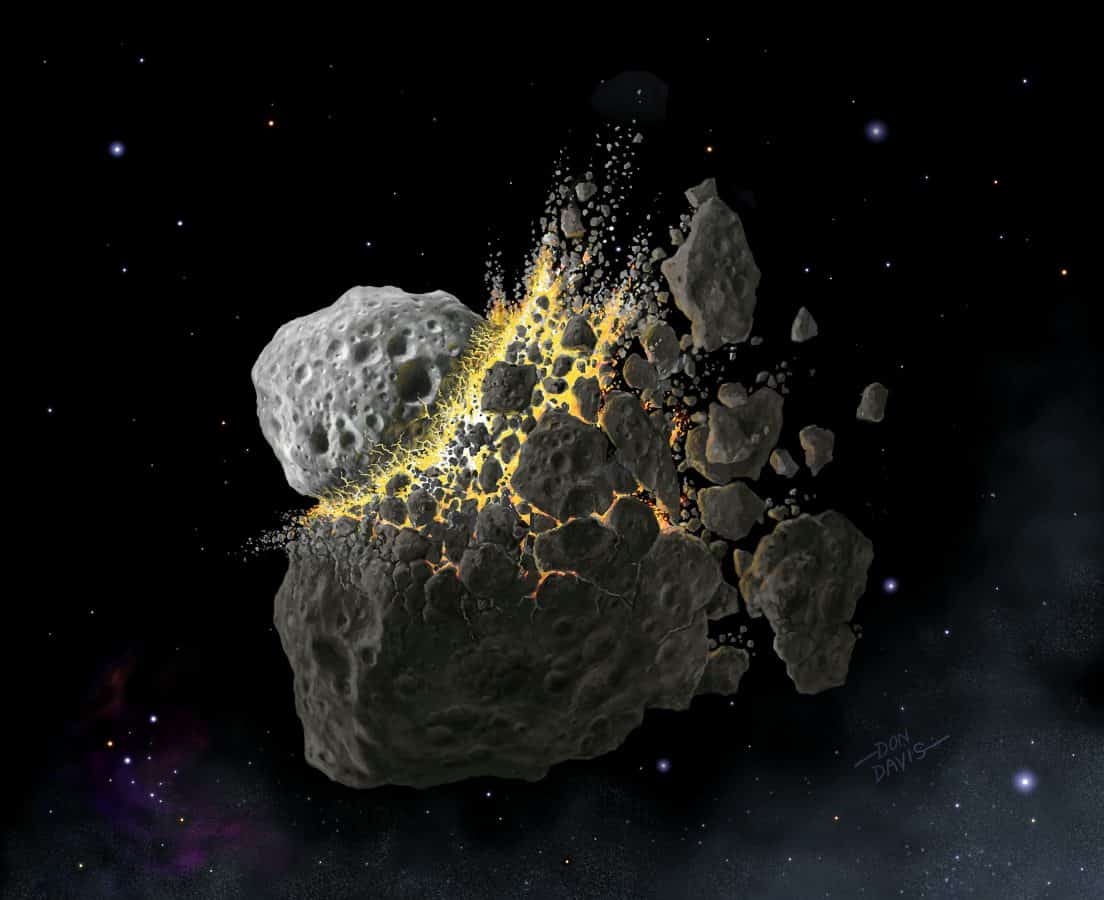
Climate change could be combated – by blowing up an asteroid just like Bruce Willis did in the movie Armageddon, according to a new study.
A cataclysmic collision between two space rocks 466 million years ago caused Earth to freeze over, say scientists.
The ancient ice age was triggered by the shrapnel raining down. Sea surfaces turned solid at the poles as temperatures dropped globally.
It was sparked when something hit a 93 mile wide asteroid between Mars and Jupiter – and it broke apart.
This led to way more cosmic dust floating down onto the planet than usual – blocking out the sun.
Co author Professor Philipp Heck said: “Our hypothesis is the large amounts of extraterrestrial dust over a time frame of at least two million years played an important role in changing the climate on Earth, contributing to cooling.”
It set the stage for species to evolve – kick starting the human race. Afterwards, the first organisms began to make their way from water onto land – allowing plants and animals to flourish.
The study published in Science Advances opens the door to reducing global warming – by destroying an orbiting asteroid.
It would mirror the plot of the 1998 sci-fi blockbuster Armageddon starring Bruce Willis.
A team of expert oil drillers are sent into space to land on a massive Earth bound rock – and detonate an explosion.
Prof Heck, curator of The Field Museum, Chicago, admitted the idea of replicating the prehistoric dust shower is tempting – but he remains cautious.
He warned: “Geoengineering proposals should be evaluated very critically and very carefully, because if something goes wrong, things could become worse than before.”
While not convinced it is the answer, Prof Heck says it is a good idea for us to be thinking along these lines.
Prof Heck said: “We are experiencing global warming – it’s undeniable.
“And we need to think about how we can prevent catastrophic consequences, or minimise them. Any idea that’s reasonable should be explored.”
The cause of the ice age, long before the dawn of the dinosaurs, was a mystery – until now.
There’s always bits of asteroids and comets in our atmosphere – but it’s only a tiny fraction of the other dust from volcanic ash, deserts and the sea.
Explained Prof Heck: “Normally, Earth gains about 40,000 tons of extraterrestrial material every year.
“Imagine multiplying that by a factor of a thousand or ten thousand.”
To put that in perspective, 1,000 articulated lorries’ worth of interplanetary dust falls to Earth in a typical year.
In the couple of million years following the collision, it would be more like ten million, said Prof Heck.
Lead author Professor Birger Schmitz, of Lund University in Sweden, said: “Our results show for the first time that such dust, at times, has cooled Earth dramatically.
“Our studies can give a more detailed, empirical-based understanding of how this works and this in turn can be used to evaluate if model simulations are realistic.”
The discovery was made by looking for traces of space dust in 466-million-year-old rocks. These were compared to tiny micrometeorites from Antarctica.
Prof Heck said: “We studied extraterrestrial matter, meteorites and micrometeorites, in the sedimentary record of Earth, meaning rocks that were once sea floor.
“And then we extracted the extraterrestrial matter to discover what it was and where it came from.”
His team treated the ancient rock with acid that eats away stone and leaves the space stuff – enabling a chemical analysis.
Other scientists had already established our planet was undergoing an ice age around this time.
The amount of water in the Earth’s oceans influences the way rocks on the seabed form. Those from this time period show signs of shallower oceans.
This suggests some of the Earth’s water was trapped in glaciers and sea ice. The study is the first to show this ice age matches the extra dust in the atmosphere.
Prof Schmitz said: “The timing appears to be perfect.”
The extra dust in the atmosphere helps explain the ice age – by filtering out sunlight, it would have caused global cooling.
Since the dust floated down to Earth over at least two million years, the cooling was gradual enough for life to adapt and even benefit from the changes.
An explosion of new species evolved as creatures adapted for survival in regions with different temperatures.
Prof Heck pointed out while this period of global cooling proved beneficial to life on Earth, fast-paced climate change can be catastrophic.
He said: “In the global cooling we studied, we’re talking about timescales of millions of years.
“It’s very different from the climate change caused by the meteorite 65 million years ago that killed the dinosaurs, and it’s different from the global warming today – this global cooling was a gentle nudge. There was less stress.”